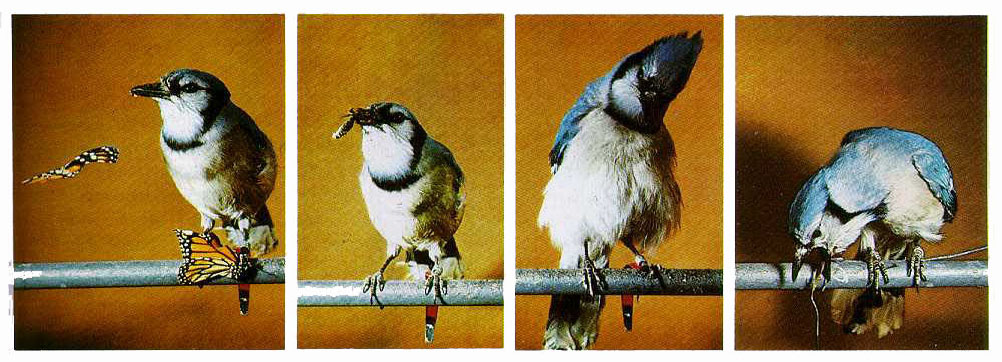即使警戒性獵物難吃,捕食者仍會攻擊高營養的個體
 |
| photo: Ornithology |
摘要
Avian predators readily learn to associate the warning coloration of aposematic prey with the toxic effects of ingesting them, but they do not necessarily exclude aposematic prey from their diets. By eating aposematic prey ‘educated’ predators are thought to be trading-off the benefits of gaining nutrients with the costs of eating toxins. However, while we know that the toxin content of aposematic prey affects the foraging decisions made by avian predators, the extent to which the nutritional content of toxic prey affects predators’ decisions to eat them remains to be tested. Here,we show that European starlings (Sturnus vulgaris) increase their intake of a toxic prey type when the nutritional content is artificially increased, and decrease their intake when nutritional enrichment is ceased. This clearly demonstrates that birds can detect the nutritional content of toxic prey by post-ingestive feedback, and use this information in their foraging decisions, raising new perspectives on the evolution of prey defences. Nutritional differences between individuals could result in equally toxic prey being unequally predated, and might explain why some species undergo ontogenetic shifts in defence strategies. Furthermore, the nutritional value of prey will likely have a significant impact on the evolutionary dynamics of mimicry systems.
面對有警戒性的物種時,行為理論預測捕食者會基於經驗或是恐新(neophobia),避免攝取這樣的物種,警戒色因此在演化上有機會越來越明顯,越來越有優勢。然而事情永遠不會這麼簡單,一來是我們永遠也不會知道鳥或蜥蜴在想什麼,二來是野外觀察者總是發現某些有毒的蝴蝶被吃掉。以個人經驗來說,就看過綠繡眼攻擊青斑蝶,也有其他觀察者看過白頭翁吃紫斑蝶。
這些東西明明就很不好吃,是捕食者蠢嗎?笨嗎?瞎嗎?或者是,捕食者實際上可以接受有點不好吃的獵物?
_RWD.jpg/799px-European_Startling_(Sturnus_vulgaris)_RWD.jpg) |
| 歐洲椋鳥 (Sturnus vulgaris) photo: European Startling (wiki) |
 |
| 麵包蟲 (Tenebrio molitor) photo from mealwormcare.org |
基於這個想法,作者群就想知道到底捕食者在冒著難以消化的風險與獲得營養的利益間如何取捨,利用歐洲椋鳥(Sturnus vulgaris)與人工調製的餌劑,以行為實驗的設計來瞭解捕食者的取捨。作者的人工餌劑調製為無防禦(0.04ml的水),低營養+防禦(0.02ml 4% 奎寧+0.02ml 水)與高營養+防禦 (0.02ml 4% 奎寧+0.02ml 營養補充劑),將其液體打進麵包蟲(mealworm)中,透過實驗動物的適應與訓練,讓牠們攻擊麵包蟲,實驗進行15次,分為無防禦與有營養獵物兩組,營養組的15次的次序分別是高營養(1-5)、低營養(6-10)、高營養(11-15),如此能得到攻擊次數與學習曲線,分析後就知道捕食者是否能夠分辨不同營養的獵物。
 |
| Fig. 1 本實驗中被吃掉的數量與測試序列。三角形為無防禦的獵物,方塊是有防禦的獵物,1-5與11-15是高營養,6-10是低營養 |
 |
| Fig. 2 高/低營養的獵物被吃掉的數量比較 |
結果顯示,捕食者面對沒有防禦機制的獵物時,完全可以接受這樣的獵物;面對有防禦機制的獵物時,攻擊次數明顯的比沒防禦的低,然而關鍵在這,在有防禦的測試中,前五次高營養(1-5)的攻擊次數比起低營養(6-10)的次數高,之後在第11-15次的高營養測試中,又回到與1-5次的學習曲線相似,這顯示捕食者是能夠迅速的評估個體的營養程度,並且做出要不要進食不容易消化個體的判斷。
這個研究只驗證一個簡單的概念,就是捕食者到底會不會主動去吃難吃但營養的食物,就像人會不會主動去吃苦瓜一樣。結果告訴我們的確有可能有這樣的情況發生,也可能讓我們對警戒色的演化產生新的觀點,但不是說這樣就解釋一切了。譬如說,實驗中的椋鳥是透過試誤的方式來學習,也就是非得要嘗試第一次不可,意思就是實際上來說,如果第一次就吃到很毒的獵物,非得要狠狠烙個一次賽,或是病個幾天,才能進行下一次評估嗎?這麼強烈的經驗還會有下次攻擊的考量嗎?(吃到一家雷店,還會考慮去第二次嗎?)也有可能就喪命,把這種個體(笨?)篩選掉。或者是鳥類有什麼辦法能直接透過視覺來評估好不好吃呢?
還有太多的問題存在其中,但這個研究無啻又掀起一些有爭議的觀點,讓我們有更多的方向討論警戒色與防禦機制與捕食者間的關係。





0 comments